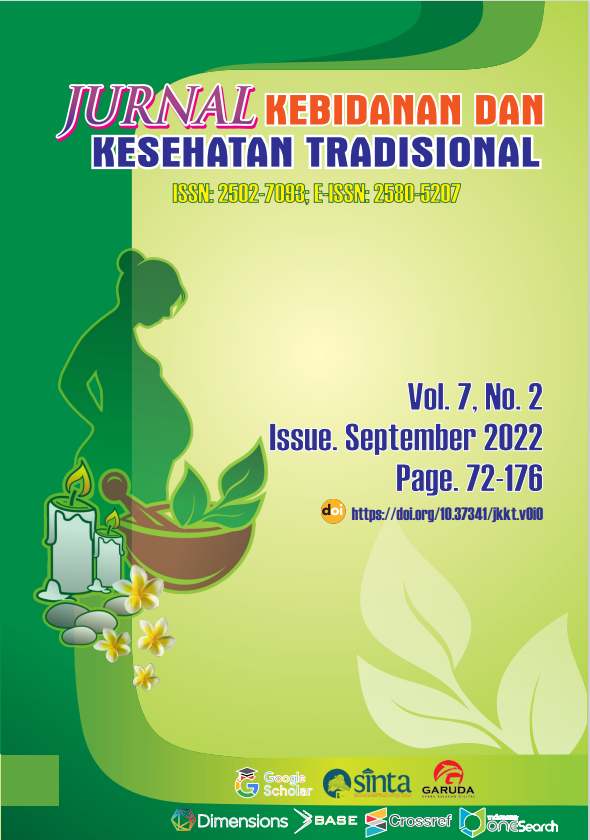Are Children Born By Sectio Caesarea (SC) Correlated With Respiratory And Autoimmune Diseases?
Main Article Content
Abstract
Background: The incidence of pulmonary and autoimmune diseases tends to be higher, which is hypothetically associated with the increasing trend of cesarean sections in our society.
Methods: This study design is analytical with a case-control approach using the odds ratio method. The study population consisted of 90 sick infants and babies, and 44 samples were obtained through a purposive sampling process with the following inclusion criteria: infants aged 0-12 months, respiratory disease (asphyxia, pneumonia, bronchopneumonia, bronchitis), autoimmune disease, rheumatoid arthritis, systemic lupus erythematosus (SLE), type-1 diabetes, multiple sclerosis (MS), Graves' disease.
Results: Most infants were born with the Sectio Caesarea method of delivery; almost all infants have respiratory disease; a small number of infants suffer from autoimmune disease; most mothers who give birth with the Sectio Caesarea method are at risk of giving birth to infants with respiratory diseases. Infants born via Sectio Caesarea (SC) have a 0.590 or 0.6 times greater risk of respiratory disease than infants born via vaginal delivery; a small proportion of mothers who give birth via Sectio Caesarea (SC) are at risk of giving birth to babies with autoimmune diseases.Infants born via Sectio Caesarea (SC) have a 1.696 or 1.7 times greater risk of developing auto-immune disease than infants born via vaginal delivery.
Conclusion: There is a relation between Sectio Caesarea (SC) and the incidence of respiratory and autoimmune diseases in infants at Kanjuruhan Hospital, Kepanjen Malang.
Article Details
References
A, I. S. (2021). 14 Jenis Penyakit Autoimun yang Perlu Diwaspadai.
A, S., J, S., K, B., & H, B. (2015). Cesarean Section and Chronic Immune Disorders. Pediatrics, 135([PubMed: 25452656] Published in final edited form as: J Law Med Ethics. 2019 December; 47(4): 568–578.), e92–e98. https://doi.org/10.1177/1073110519897732.
Diantini, D.M.A.1, Ulandari, N.L.1, Wirandani, 1, N. K. N. S., … Kumara, K. . (2016). Angka Kejadian Penyakit Autoimun Pada Pasien Anak Di Rsup Sanglah Denpasar. Jurnal Farmasi Udayana, 5 no 2.
DM, C., J, M., AL, P., KM, A., MD, S., & KM, A. (2017). Maturation of the infant microbiome community structure and function across multiple body sites and in relation to mode of delivery. Nat Med, 23:314–326.
Erick Fransisco. (n.d.). Enam Risiko bayi Sesar. Retrieved from https://tekno.kompas.com/read/2009/12/23/1126248/~Kesehatan~Anak
F, F. (2015). Sectio Secarea sebagai faktor Resiko Kejadian Asfiksia Neonatorium. Majority, 4(nomor 8), 57–67.
J, C. A., K, S., A, D., JS, K., Eimear, B., & J, D. (2016). Vaginal seeding” of infants born by cesarean section. BMJ Glob Health, 352 :i227.
J, H., P, P., & B, M. (2018). Potential Transmission of Herpes Simplex Virus via Vaginal Seeding. The Pediatric Infectious Disease Journal 37, (no 11).
K, K., & I, H. (2016). Caesarea Section and disease associated with immune function. J. Allergy Clin Immunol, 137;587-90.
L, H., Q, C., & Y, Z. (2015). Is Elective Cesarean Section Associated with a Higher Risk of Asthma? A Meta-Analysis. Journal of Asthma 52, 1, 16–25.
M, N. T., KH, S., H, D. E., L, L., V., E. C., C, B., … B, D. (2019). Bacterial Baptism: Scientific, Medical, and Regulatory Issues Raised by Vaginal Seeding of C-Section-Born Babies. J Law Med Ethics, December ;, 568–578. https://doi.org/10.1177/1073110519897732
MC, M., SE, H., & H, S. (2011). Delivery by Cesarean Section and Early Childhood Respiratory Symptoms and Disorders: The Norwegian Mother and Child Cohort Study. American Journal of Epidemiology, 174, no. 11 (2011): 1275–1285; [PubMed: 22038100].
MG, D.-B., KM, D. J.-L., & N, S. (2016). Partial Restoration of the Microbiota of Cesarean-Born Infants via Vaginal Microbial Transfer. Nature Medicine, no.3, 250–253. https://doi.org/10.1038/nm.4039.
Midwives, M. textbook for. (2011). No Title. In Buku ajar bidan Edisi :14. Jakarta: EGC.
Miettinen R, Hermansson H, Merikukka M, Gissler M, I. E. (2015). mode of delevery impact on risk of noncommunicabble dieses. J Allergy Clin Immunol, 136; 1398–1399.
Ngo, S. T., F. J. Steyn, P. A. M. (2014). Gender Differences in Autoimmine Disease. Frontiers in Neuroendocrinology, 35, 347–369.
PUSDATIN, I. (2017). Situasi Lupus di Indonesia. Pusat data dan Informasi Kementrian Kesehatan RI.
R, N., H, T., T, T., K, K., S, N., K, N., & Y, Y. (2017). Gut dysbiosis following C-section instigates higher colonisation of toxigenic Clostridium perfringens in infants. Benef Microbes, 8, 353–365.
Revinder Nagpal, Y. Y. (2018). Gut Microbiota omposition in healthy japanase infans and young Adults born by C-section. Ann Nutr Metab, 73, 4–11. https://doi.org/10.1159/000490841
RI, K. (2019). Profil Kesehatan Indonesia Tahun 2018.
S, W. (n.d.). Penyakit-Penyakit Autoimun. Elek Media Komputindo.
Schuller RC, S. D. (2014). Sectio caesarea: actual controversy. Ther Umsch., (71(12)), 717–22.
Słabuszewska-Jóžwiak, Szymański, M, C., B, S.-H., & G, J. (2020). Pediatrics Consequences of Caesarean Section-A Systematic Review and Meta-Analysis. Int. J. Environ. Res. Public Health 17. https://doi.org/10.3390/ijerph17218031
Wandell, P. E. and A. C. C. (n.d.). Time Trends And Gender Differences In Incidence and Prevalence of Type 1 Diabetes In Sweden. Curr Diabetes, Vol. 9 (4), 342-349.

